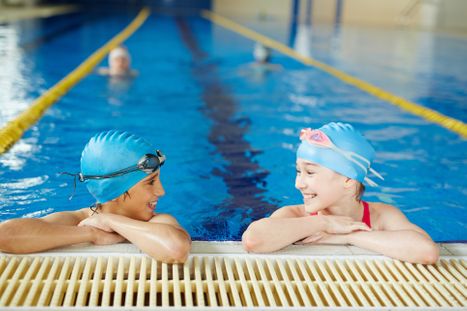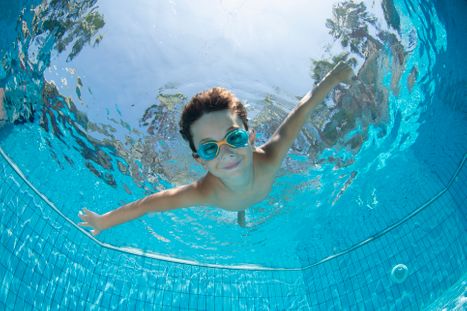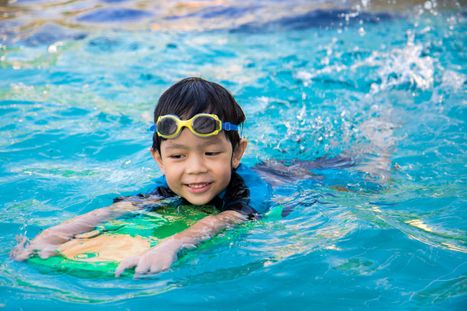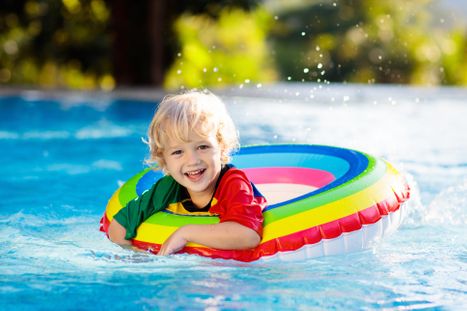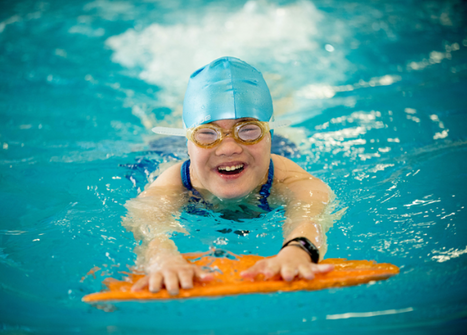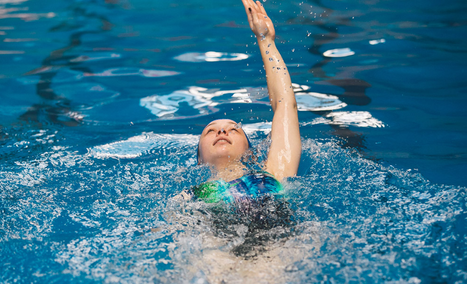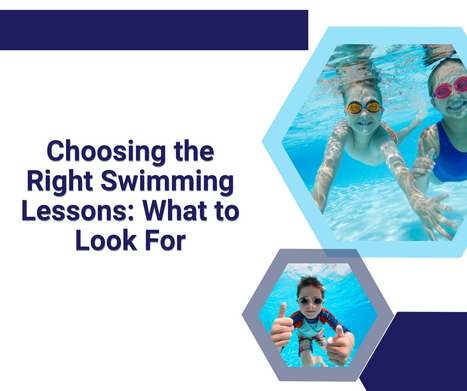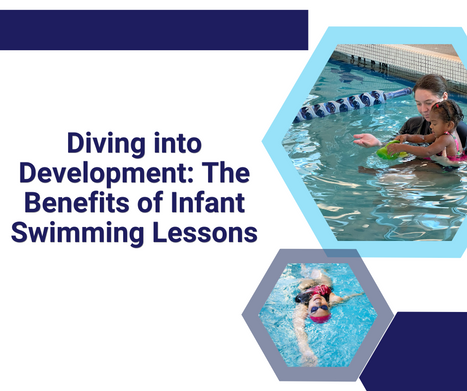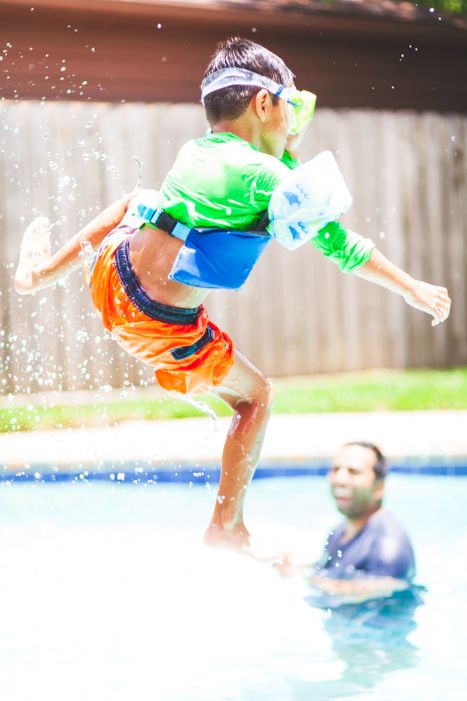Blog
The Benefits of Swimming for Children's Physical and Mental Health
Swimming is not only a fun and refreshing activity for children but also offers a wide array of physical and mental health benefits. Let's delve into the numerous advantages that swimming provides for children's overall well-being.
Physical Development
· Swimming is a low-impact, full-body exercise that significantly contributes to a child's physical development. It encourages healthy growth and aids in the development of strength, coordination, and balance. Additionally, it equips children with essential water safety skills, making it a holistic exercise for their physical well-being.
Brain Development
· Studies have shown that children who learn to swim earlier reach developmental milestones including speech, literacy, numeracy, and visual-motor skills much earlier than their peers and non-swimmers. Furthermore, swimming can help improve memory, mood, clarity, focus, and sleep, ultimately aiding in stress reduction and improved behavior.
Stress Relief
· The release of endorphins during swimming combats stress hormones, and the rhythmic actions of swimming positively counteract the symptoms of stress. The water's inherent properties also provide a relaxing and stress-relieving environment for children.
moreSaving Lives: A Parent’s Guide to Preventing Childhood Drowning
Drowning is a significant and preventable cause of death among children, with children aged 1-4 being particularly vulnerable. According to a study by the CDC, drowning deaths in the United States have seen an alarming increase, with over 4,500 deaths annually from 2020-2022, indicating a rise in drowning rates compared to previous years.
Alarming Statistics
- Drowning is the number one cause of death for children aged 1-4 in the United States, with the highest drowning rates among this age group.
- The study found that almost 40 million adults (15.4%) in the United States do not know how to swim, and over half (54.7%) have never taken a swimming lesson.
- Particularly concerning is the fact that 63% of Black adults and 72% of Hispanic adults reported never taking a swimming lesson.
Importance of Swimming Lessons
The study revealed a protective association between past participation in formal swimming lessons and the risk of drowning in children aged 1 to 4 years, indicating an 88% reduction in the risk of drowning among those with swimming lessons. This underscores the importance of swimming lessons in preventing childhood drowning.
moreThe Importance of Children Swimming Year-Round for Independence and Summer Safety
Swimming is a crucial life skill for children, offering not only physical and mental health benefits but also instilling a sense of independence and safety, particularly during the summer. According to the Centers for Disease Control and Prevention (CDC) approximately 79% of children spend time near the water during the summer, whether it’s a pool, lake, or a beach. Embracing swimming as a year-round activity for children can significantly enhance their confidence, competence in the water, and ensure a safe and enjoyable summer experience.
The Significance of Year-Round Swimming for Children
Physical Health and Development
- Swimming provides an excellent form of physical exercise for children, promoting cardiovascular health, muscle development, and overall fitness.
- Regular swimming from an early age can contribute to the development of strong motor skills and coordination.
Water Safety
- Year-round swimming enables children to continuously improve their water safety skills, equipping them to handle potential water-related emergencies.
- According to data from the American Red Cross, only 64% of children who spend time near the water in the summer have basic swimming skills. Familiarity with water safety guidelines and practices from regular swimming can significantly reduce the risk of accidents during summer water activities.
5 Essential Skills Every Beginner Swimmer Should Master
Swimming is not only a valuable life skill but also a fantastic way to stay fit and healthy. Whether you're a child or an adult, learning to swim can be an enjoyable and rewarding experience. As a beginner, mastering certain essential skills is crucial to becoming a confident and competent swimmer. Here are five essential skills every beginner swimmer should aim to master:
1. Floating
Floating is a fundamental skill that every beginner swimmer should strive to master. It not only helps build water confidence but also serves as the foundation for learning other swimming strokes. Being able to float effortlessly on the water's surface provides a sense of security and relaxation, making it easier to progress to more advanced skills. There are various floating techniques, including back float, front float, and survival float, each offering unique benefits and helping swimmers develop essential balance and coordination in the water.
2. Kicking
Learning proper kicking techniques is another essential skill for beginner swimmers. Effective kicking not only propels the body through the water but also helps maintain balance and stability. Beginners should focus on developing a strong and steady kick, whether it's for freestyle, breaststroke, or backstroke. Practicing kicking drills and exercises can significantly improve leg strength and overall swimming efficiency, laying a solid foundation for mastering different swimming styles.
moreVisual Water Safety: How Your Swimsuit Color Impacts Pool Safety
When it comes to pool safety, we often think about factors like lifeguards, signage, and depth markers. However, one aspect that might not immediately come to mind is the color of bathing suits. Believe it or not, the color of your swimsuit can play a role in your safety while swimming. Let's dive into why the color of bathing suits matters and how it can affect the safety of your child in the pool.
Importance of Swimwear Visibility in a Pool Setting
First and foremost, visibility is key when it comes to pool safety. Brightly colored swimsuits, such as neon greens, oranges, and pinks, are easier to spot in the water, especially in crowded pools or busy aquatic environments. This increased visibility makes it easier for lifeguards to keep track of swimmers and react quickly in case of an emergency. When wearing a bright-colored swimsuit, you're more likely to stand out against the water's backdrop, making it easier for others to see you.
Your Color Choice Can be a Danger for Pool Visibility
On the contrary, darker-colored swimsuits can blend into the water, making it harder for lifeguards and other swimmers to see you. In low-light conditions or murky water, or when there is a high degree of activity in the pool, this lack of visibility can be even more pronounced, increasing the risk of collisions or accidents. Additionally, darker colors absorb more sunlight, potentially causing the wearer to feel hotter and more uncomfortable under the sun's rays.
moreSwimming During the Winter: Year-Round Benefits
Winter is often associated with snuggling up indoors, snow sports and sipping hot cocoa. Water activities are the last thing on your mind! However, swimming during the winter season can be an incredibly rewarding and invigorating experience, not to mention important. Indoor swimming pools provide a controlled environment that allows you to enjoy the benefits of swimming all year round, regardless of the weather outside. It also prepares you in advance for swimming in the more popular warm weather season. In this blog, we will explore the numerous benefits and joys of indoor swimming in the winter, along with essential safety tips to ensure a pleasant and safe swimming experience.
Benefits of Indoor Swimming in Winter
1. Maintain Fitness: Swimming is a low-impact exercise that works out your entire body. By swimming indoors during winter, you can maintain your fitness levels and keep those holiday calories at bay. Regular swimming sessions help improve cardiovascular health, build endurance, and strengthen muscles, all while reducing the risk of injuries.
2. Boost Immunity: Winter is notorious for colds and flu, but swimming can help strengthen your immune system. The warm and humid environment of indoor swimming pools can help open up your airways, clear congestion, and reduce the occurrence of respiratory illnesses. Additionally, swimming boosts circulation, which aids in the delivery of oxygen and nutrients throughout the body, enhancing overall immunity.
moreISR vs. Learn-to-Swim
Sean Arroyo, Hudson Valley Swim National Aquatics Director
Upon first hearing about the ISR program many years ago, I must admit that I was intrigued. After all, watching the videos of infants being thrown into the water completely clothed, and then watching them roll onto their back to float and then cry, I thought to myself that this was remarkable. I even investigated getting certified immediately! After researching the subject, I discovered there was not much of a market for ISR in NY, so I decided not to pursue it.
Over time I encountered a few alumni of ISR, and my observations are for starters that the program works! These babies do know how to roll onto their backs almost immediately upon getting their face wet. With them on their backs they then begin to scream and cry so that an adult is alerted as designed. This was great except when I tried to show them other skills, I could not get them to relax and stop crying. In fact, they wanted to get out so quickly I did not have the chance to even play or teach any other skills. This was true with each of the alumni of the program that came to me for lessons. Each child was very fearful of the water.
ISR is a hard water introduction while at Hudson Valley Swim, our infant program is a soft introduction to the water. We understand the importance of creating a fun and safe learning environment for all our little swimmers. We use songs and well thought out organized games and activities geared toward getting each child comfortable with the water. This also helps moms and dads during tubby time at home. We do focus on submersion and getting the little ones to roll over and float on their backs, but we do so in a more nurturing way; one that builds confidence and helps them develop a fun and safe relationship with the water. This is more conducive to learning the skills they need to keep themselves safe and to give parents peace of mind.
moreThe Incredible Benefits of Swimming Lessons for Special Needs Children
The skill of swimming comes with numerous advantages and is of great value for children of all abilities. However, its advantages become even more pronounced for children with special needs. Learning to swim not only enhances physical fitness but also plays a pivotal role in boosting self-confidence and imparting a life-saving skill. In this blog, we will explore the myriad benefits that swimming lessons provide for children with special needs and how it can positively impact their lives.
1. Physical Development: Swimming aids in developing muscle tone, strength, and coordination for children with disabilities. It allows them to move freely and independently, strengthening all limbs in the process. The water's buoyancy reduces pressure on the limbs, relieving pain and facilitating a greater range of motion. Furthermore, swimming fosters improved balance and motor skills, contributing to overall physical development.
2. Self-Confidence and Social Interaction: Many children, including those with special needs, experience a remarkable sense of achievement when learning to swim. As they conquer new boundaries and explore their capabilities, their self-confidence soars. Swimming lessons also expose them to new social interactions, creating a supportive and inclusive environment. Working as a team and engaging with peers helps develop valuable social skills, promoting a sense of belonging and camaraderie.
moreDiving Deeper: Overcoming Advanced Swim Challenges
For experienced swimmers, the thrill of diving into the water and gliding effortlessly through its depths can sometimes start to wane. As you become more proficient in the sport, it's natural to seek new challenges and push your limits. This is where overcoming advanced swim challenges comes into play. In this blog, we will explore tips and advice for experienced swimmers looking to redefine their skills and dive deeper into the world of swimming.
1. Set Clear Goals: To overcome advanced swim challenges, it is essential to set clear goals. Define what you want to achieve in terms of technique, speed, or endurance. Break down these goals into smaller, manageable steps to track your progress effectively. Whether it's perfecting your stroke technique or competing in a challenging open-water event, having a clear goal will provide direction and motivation.
2. Seek Professional Guidance: To refine your skills and overcome advanced swim challenges, consider seeking professional guidance. Enroll in advanced swim clinics or hire a swim coach who can provide personalized feedback and guidance. An experienced coach can analyze your technique, identify areas for improvement, and provide you with tailored drills and exercises to enhance your skills.
moreOvercoming Swimming Anxiety for Kids: A Guide for Parents
Swimming is a valuable life skill that not only offers physical benefits but also instills confidence and fosters a love for water activities. However, some children may develop swimming anxiety, making it challenging for them to enjoy the water. As a parent, you can play a crucial role in helping your child overcome this anxiety and develop a lifelong love for swimming. In this guide, we'll explore effective strategies to help your child conquer their swimming fears.
Understanding Swimming Anxiety
Swimming anxiety can manifest in various ways, from fear of water to nervousness about swimming in deep pools or open water. Understanding the root cause of your child's anxiety is the first step in addressing it. It could be due to a past negative experience, fear of drowning, or a general discomfort in the water.
Creating a Positive Environment
To help your child overcome swimming anxiety, it's essential to create a positive and supportive environment. Start by choosing the right swimming facility. Look for a pool that offers swim lessons specifically designed for children with anxiety. These classes often have smaller group sizes and instructors trained to work with anxious swimmers.
moreChoosing the Right Swimming Lessons: What to Look For
Swimming is an invaluable skill that offers a multitude of benefits. Whether you're a parent seeking lessons for your child or an adult eager to acquire this essential skill, finding the right swimming lesson program is a pivotal decision. Here are some key factors to consider when selecting swimming lessons to ensure a safe, effective, and enjoyable learning experience.
1. Experienced Instructors: The expertise of the instructors is perhaps the most critical aspect of any swimming lesson program. Experienced instructors possess the knowledge and skills to teach swimming techniques effectively, tailor lessons to different skill levels, and ensure the safety of all participants.
2. Small Class Sizes: It is no secret that having smaller classes in any educational environment is most conducive to learning. This is especially true for swimming lessons. Repetition is critical and if there is only a few minutes of one-on-one time with an instructor, progress will take a long time unless class sizes are minimized.
3. Structured Curriculum: Whether you're a beginner or looking to improve your existing skills, the lessons should be organized in a logical sequence that gradually builds upon foundational techniques. A comprehensive curriculum should cover water safety, basic strokes, breathing techniques, and advanced skills as you progress.
moreDiving into Development: The Benefits of Infant Swimming Lessons
When it comes to nurturing a child's physical and cognitive development, parents are always on the lookout for activities that offer a holistic approach. One such activity that has gained significant attention in recent years is infant swimming lessons. Far from being a mere recreational activity, these lessons can be a game-changer for your child's growth and well-being. We will help you debunk common misconceptions, and provide insights into how early aquatic exposure can set the stage for a lifetime of health and confidence.
1. Water Safety Skills from the Start: Drowning is a leading cause of accidental deaths among young children. Infant swimming lessons lay the foundation for water safety awareness, teaching even the tiniest learners how to hold their breath, turn over on their back to float, and move around in the water. These essential skills can significantly reduce the risk of water-related accidents and empower children to react effectively if they find themselves in a precarious situation.
2. Developmental Milestones Acceleration: Infant swimming isn't just about splashing around; it's a comprehensive developmental activity. The gentle resistance of water enhances motor skills and sensory experiences, contributing to better balance and spatial awareness. Early aquatic exposure can potentially expedite milestones like crawling, walking, and even early speech development.
moreWater Confidence: Dive In and Overcome Your Fear!
For some individuals, water can also be a source of fear and anxiety. This fear, known as aquaphobia, can restrict people from fully enjoying water-related activities and experiences. We will delve into the concept of water confidence and explore effective strategies to overcome the fear of water.
Understanding Aquaphobia: Aquaphobia is a common fear that affects many individuals, young and old alike. It can stem from various causes, such as a traumatic water-related incident, a lack of exposure to water during childhood, or even hearing about the negative experiences of others. The fear can manifest in different ways, ranging from mild unease and discomfort to severe panic attacks when in or near water. However, the good news is that with the right mindset and approach, aquaphobia can be overcome.
Building Water Confidence:
Knowledge is Power: Educate Yourself. One effective strategy to combat aquaphobia is to gather knowledge about water-related activities, safety measures, and swimming techniques. Understanding how water behaves, the buoyancy it provides, and the basic principles of swimming can help demystify the unknown and build your confidence.
more
Overcoming Water Anxiety in Individuals with Autism: A Journey of Empowerment
For many individuals on the autism spectrum, water-related activities can be a source of anxiety and stress. The sensory experiences and unpredictable nature of water can be overwhelming, leading to a fear of swimming pools, beaches, or even taking a bath. However, it is essential to recognize that water is not only a vital element for our well-being but also offers numerous benefits for physical and emotional health. We are sharing strategies and tips to help individuals with autism overcome water anxiety and embrace the joy of aquatic activities.
Understanding Water Anxiety: Water anxiety is a common challenge faced by individuals with autism spectrum disorder (ASD). It often stems from sensory processing difficulties, fear of the unknown, and challenges with social communication. The sound, feel, and temperature of water can be overwhelming, leading to heightened anxiety and a strong aversion to water-related activities.
Overcoming Water Anxiety:
Gradual Exposure: Start with small steps to gradually desensitize individuals to water-related experiences. Begin by introducing water in a controlled environment, such as a small tub or basin. Encourage them to explore the water at their own pace, touching it, and gradually getting comfortable with its sensory properties.
more
The Zen of Swimming: Finding Peace and Mindfulness in the Water
In the hustle and bustle of our modern lives, finding moments of peace and tranquility can be challenging. However, there is a serene oasis that offers respite from the chaos—a place where you can immerse yourself in calmness and embrace a sense of mindfulness: the water. Swimming, with its rhythmic strokes and weightless buoyancy, has the power to unlock a unique form of meditation.
Swimming can help with the meditative and calming aspects. We also explore how being in the water can promote mindfulness, stress relief, and overall mental well-being. Swimming lessons in Stamford, CT can help you achieve the list below.
The Flowing Rhythm of the Water:
Swimming provides an opportunity to embrace the flowing rhythm of the water, creating a soothing and meditative experience.
Consider the following aspects:
a. Focus on Breath: Aligning your breath with your strokes creates a rhythmic pattern that calms the mind and enhances mindfulness. Concentrate on the sensation of air entering and leaving your body, syncing it with the ebb and flow of the water.
more
From Pool to Open Water: Transitioning and Thriving in Open-Water Swimming
Many swimmers who have honed their skills in the pool eventually feel the pull of open-water swimming, seeking to explore new challenges and environments. Venturing into the vast expanse of lakes, rivers, or oceans can be an exhilarating experience, but it also requires careful preparation and consideration.
Here are valuable insights and guidance for swimmers looking to transition and thrive in open-water swimming. From the unique challenges to safety considerations, training tips, and equipment recommendations, we'll cover it all.
Understanding the Unique Challenges: Open-water swimming presents a set of challenges that differ from swimming in a controlled pool environment.
Some key factors to consider include:
a. Navigation: Unlike a pool with clear lane lines, open water lacks visual cues. Learning to navigate efficiently using landmarks, buoys, or GPS devices is essential.
b. Water Conditions: Open-water environments can vary greatly in terms of waves, currents, and temperature. Familiarize yourself with the specific conditions and practice adapting to them.
moreHow to Stay Safe While Swimming: Important Tips for Swimmers
Swimming is a wonderful activity that many enjoy, especially in the warmer months. Whether you're taking a dip in the pool, swimming in the ocean, or enjoying a serene lake, it's essential to prioritize safety while in the water. By following a few important tips, you can ensure that your swimming experience remains safe and enjoyable.
Learn to Swim: The foundation of staying safe in the water starts with learning how to swim. Enroll in swimming lessons if you haven't learned already. Proper swimming skills and techniques will give you confidence and control, allowing you to navigate the water more effectively. We offer swimming lessons for all ages and abilities starting at 6 months old to adults in Stamford Ct.
Swim in Designated Areas: Always swim in designated areas that are supervised by lifeguards. These areas are regularly inspected for safety and have professionals trained in water rescue. Their presence provides an added layer of security and immediate assistance in case of emergencies.
Swim with a Buddy: Swimming with a buddy is an essential safety measure. Having someone with you while you swim ensures that there is someone to help or seek assistance if needed. This is especially important in open water, where unexpected currents or fatigue can pose risks.
more
10 Essential Swimming Techniques Every Swimmer Should Master
Swimming is not only a fun and refreshing activity but also an excellent way to stay fit and healthy. Whether you're a beginner or an experienced swimmer, mastering essential swimming techniques is crucial to improve your efficiency, speed, and overall performance in the water. By incorporating techniques into your swimming routine, you can enhance your skills and enjoy the water to the fullest during the summer months in Stamford, CT.
Freestyle (Front Crawl): Freestyle, also known as the front crawl, is the most commonly used swimming stroke. It is a dynamic stroke that involves rhythmic arm movements, a continuous flutter kick, and controlled breathing. Mastering the freestyle technique will not only help you swim efficiently but also increase endurance.
Backstroke: The backstroke is swum on the back, with the arms moving alternatingly and the legs kicking in a flutter kick style. This technique requires coordination and balance, as well as the ability to navigate without seeing where you're going. Backstroke is an excellent stroke for relaxation and recovery during longer swims.
Breaststroke: Breaststroke is a slower-paced stroke that involves a simultaneous arm movement followed by a powerful leg kick. It requires coordination between the arms, legs, and breathing. Mastering the breaststroke technique can help you build strength and endurance while maintaining an efficient swimming posture.
more
Water Safety Month PSA: Responsibility of Pool Ownership
Swimming pools are a great way to cool off and have fun during the summer months, but it's important to remember that they can also be dangerous if proper safety precautions are not taken. Water safety in pools is an essential aspect of pool ownership and operation, and it's critical to ensure that everyone who owns a pool is aware of the potential hazards and how to avoid them.
Here are some essential tips for maintaining water safety in pools:
Fence the pool area: One of the most effective ways to prevent accidents in and around the pool is to install a fence around the pool area. The fence should be at least four feet high, and the gate should be self-closing and self-latching. This will help to keep young children and pets from accessing the pool area without adult supervision.
Keep the pool clean: Maintaining proper hygiene in the pool is essential to prevent the spread of bacteria and viruses. Make sure to test the water regularly and adjust the chemical balance as needed. Additionally, remove any debris from the pool surface to prevent slips and falls.
Supervise children: Children should always be supervised while swimming in the pool. Even if they are proficient swimmers, accidents can happen quickly and without warning. Never leave children unattended in or around the pool, and make sure that they understand the pool rules and safety guidelines.
more
Water Safety Month PSA: Drawbacks of Children Using Swimmies
Swimmies, also known as arm floaties, are a popular choice for parents who want to ensure their children's safety in the water. These inflatable bands are worn around a child's arms, providing buoyancy and helping them stay afloat. However, while they may seem like a good idea, there are several reasons why using floaties isn't a good idea.
Floaties can create a false sense of security. Parents may assume that their child is safe with floaties on and become less vigilant. However, they are not a substitute for adult supervision. Accidents can still happen, and a child can quickly become overwhelmed in the water, even with floaties on.
Floaties can create bad habits. Children may become reliant on them and not learn how to properly swim. They may also develop a habit of relying solely on their arms for buoyancy, which can hinder their ability to properly kick and develop proper swimming techniques.
A child can forget they are not wearing their floaties and jump in the water. Without survival or swimming skills, a child may be vulnerable.
They can be uncomfortable and restrict movement. They can rub against a child's skin and cause irritation, and they can also make it difficult for a child to move their arms freely.
more
General Water Safety
Protecting your children against drowning is not difficult. Your primary responsibility to keep them safe is simply to supervise them; whether in the pool or the bathtub.
You only have to remember one thing: ALWAYS SUPERVISE YOUR CHILD AROUND IN AND AROUND WATER!.
Put your phone down.
Put your book down.
Face the water instead of the sun or your friends.
Give your child 100% of your attention.
If you, or your child, is not confident with water, we encourage you to take swimming lessons.
moreKnow The Signs of Dry Drowning
The terms “dry drowning” and “secondary drowning” (also called submersion injuries) are often used interchangeably — even by some experts — but they’re actually different conditions, says Mark R. Zonfrillo, M.D., MSCE, attending physician in the Department of Emergency Medicine at the Children’s Hospital of Philadelphia.
In dry drowning, someone takes in a small amount of water through his or her nose and/or mouth, and it causes a spasm in the airway, causing it to close up.
In secondary drowning, the little bit of water gets into the lungs and causes inflammation or swelling that makes it difficult or impossible for the body to transfer oxygen to carbon dioxide and vice versa.
Dry drowning usually happens soon after exiting the water, but with secondary drowning, there can be a delay of up to 24 hours before the person shows signs of distress. Both can cause trouble breathing and, in worst-case scenarios, death.
moreSwimming Safety Tips: Active Supervision
Whenever infants or toddlers are in or around water, an adult should be within arm’s reach to provide active supervision. We know it’s hard to get everything done without a little multitasking, but this is the time to avoid distractions of any kind. If children are near water, then they should be the only thing on your mind. Small children can drown in as little as one inch of water.
When there are several adults present and children are swimming, use a schedule strategy to allot each adult a certain amount of time (such as 30-minute periods) to prevent lapses in supervision. At Hudson Valley Swim, we find this swimming technique to work very well.
For an additional resource on sun and water safety, Love Holidays has published a study on Keeping Your Kids Safe on a Family Holiday. You may find the full guide here.
Make sure to check out the swimming lessons that we offer.
moreGet the Beautiful Beach Bod and Mind by Swimming
Who doesn’t want to look incredibly intriguing and become the center of attraction with a great figure while on the beach? Flaunt your fit frames and great beach body which you have worked hard to get! What is so bad about desiring to look great? And besides looking great, how about feeling great too? Swimming is a great way to work your body and mind and the results give you a sense of self-confidence. What if you are not an accomplished swimmer? Is it too late to learn? Not at all, but you will need to start by learning how to work properly in the water.
moreSwimming for Special Needs Children
Swimming lessons for children with special needs are beneficial not only for their physical health but also to improve their behavioral and mental health. It helps them to obtain good stamina, muscle strength, better behavioral conditioning, body flexibility, better self-control, coordination, etc. Moreover, spending time in the water keeps the children relaxed and calm, hence they are motivated to spend more time in the water, which further expands on these benefits. Let’s discuss some points on swimming for children with special needs:
moreWater Safely & Drowning Prevention Tips
Drowning is one of the major causes of death among all ages people, especially kids, and teens. Not to speak of swimming pools, infants or toddlers may drown even in bathtubs or buckets. Approx 1,500 kids and teens die every year in the US due to drowning. Most of the departed souls were either having fun swimming, boating or just playing in or around the water.
However, we all can prevent or diminish the risk of drowning if we are a bit conscious of water safety measures and follow the rules of drowning prevention.
moreWinter is a great season to learn how to swim!
Sure it’s cold! And yes it is a pain to get everyone bundled up to go outside. But it is warm in the gym and especially in the pool area. And the water is at least 85 degrees in our pool facilities. Here are some great reasons to keep swimming over the winter at Hudson Valley Swim
moreSwimming For Physical and Mental Health!
We all know how important exercise is for a healthy mind and body. While there are many ways to exercise, swimming is widely known as one of the best and is also a lot of fun while working out.
moreToddler Swim Classes: A Refreshing Way to Learn & Develop
Nothing can be more energizing and refreshing in hot summers than swimming in a cool pool while enjoying the warmth of the sun. Swimming is an exercise, a meditation and a sport that can benefit you in all the possible ways and make you feel relaxed and rejuvenated at the same time. It is equally important for the kids, teenagers, youths and adults as water knows no age bars, but it is better to learn swimming at an early age, so that the child can improve his skills with age and stay fit throughout his life. There are myriad of benefits of learning swimming at an early age. Some of them are discussed here:
moreBeat The Heat of a Blistering Summer….Safely!
There is no better way to beat the heat of the summer than by spending it in the water. Swimming is a great recreational sport that can be enjoyed by all ages at any time of the year; but of course summer is the best. But please…..keep safety in mind!
moreWhy Should Kids Have All The Fun?
In our life, we often encounter moments when we think, “I wish, I would have learned this or done that”! Normally, it is never too late to learn new things, especially a skill that can be both enjoyable and lifesaving. One such skill that fits these criteria and is good for any age or gender, is “swimming”.
Swimming offers many advantages to our bodies. It not only is an incredible way to stay healthy and fit, but is also a must-have skill for safety reasons. Swimming is an exercise that uses all of our body muscles together to propel through the water. Hence, swimming is a boon for those fitness lovers who want to burn fat without the sweat. Additionally, no matter whether you are an adult or a teenager, you can drown in water as easily as a child can; unless you have sufficient swimming skills. Thus, you should consider enrolling in a swimming class, regardless of your age.
With an experienced instructor who truly understands your fear and your passion of learning, you can have an enjoyable experience while exercising and learning safety skills. Thus, you should always evaluate the swimming programs in your area to ensure their instructors are trained in your needs, are insured and have class sizes small enough for an enhanced learning experience. If you are looking for a swim school that meets these criteria, consider talking to Hudson Valley Swim.
moreStart Baby Swimming Lessons Before the Age of 1
Your baby may not be able to walk but he or she can certainly start to learn swim. At Hudson Valley Swim, our trained instructors use various techniques that we have honed over time to teach kids as young as 6 months and older, swim skills that will stay with them for life. You’ll find some additional benefits to jumping into lessons now, like these Reasons to Start your Baby Swimming Before the Age of 1.
moreWhy Swimming is Important for Everyone?
Swimming is an important sport and should be enjoyed by everybody as it has several health benefits. Swimming increases metabolism and helps energize your body and mind. Doctors suggest swimming to patients after surgery because the density of water takes the pressure off of their bones and joints which helps them recover without additional pain. It really is the only exercise like it. Additionally, swimming is the only exercise that has an effect on the entire body.
moreBenefits of Swimming for Adults
There are numerous benefits that adults can realize when they are swimmers. Often, doctors have begun advising their adult patients to begin swimming as a safe and enjoyable way to realize the health benefits of routine aerobic physical activity. According to the CDC, just a few hours a week of aerobic exercise like swimming can decrease the chance of acquiring chronic or even serious health conditions. Here are several reasons that make swimming the ideal sport for adults.
moreCan My Baby Take Swimming Lessons?
When your baby is 5-6 months old, you can join a parent-child swimming class such as the Pollywog class taught by Hudson Valley Swim. You'll be in the water with your baby during these classes, which are opportunities for them to be around other babies and become comfortable in the water – not learn true swimming skills. Your child probably won't be developmentally ready for formal swim lessons until approximately age 3.
The American Academy of Pediatrics (AAP) says classes for children younger than 3 can be enjoyable and helpful but warns that many parents may become overly confident about how much their child learns in these classes. The AAP advises that an adult is within arm's length – close enough to touch – whenever infants and toddlers are in or near water.
At Hudson Valley Swim, we feel that your child is ready to take swim lessons on their own when they’re able to listen to an instructor for the whole class and follow their directions. Your child should also be comfortable around water before taking swim lessons solo – if they hate bathing or haven’t been around the water much, it might be a good idea to take them to an age-appropriate parent-child class first.
moreGet the Facts on Drowning from the CDC
Every day, about ten people die from unintentional drowning. Of these, two are children aged 14 or younger. Drowning ranks fifth among the leading causes of unintentional injury death in the United States.
- 4,000 Every Year: An average of about 4,000 people die from drowning every year. That is more than 10 people every day.
- 20% Are 14 and Under: One in five people who die from drowning are children 14 and younger.
- 5X More Are Non-Fatal: For every child who dies from drowning, another five receive emergency care for nonfatal submersion injuries
So let’s take a look at who is most at risk
- Males: Nearly 80% of people who die from drowning are male.
- Children: Children ages 1 to 4 have the highest drowning rates. About 30% of children ages 1 to 4 who die from a fatal accident, do so by drowning. In fact, in this age group, drowning is the 2nd leading cause of death, behind car accidents.
- Minorities: The fatal drowning rate of African American children ages 5 to 14 is almost three times that of white children in the same age range. In swimming pools, African American children ages 5-19 drown at rates 5.5 times higher than those of whites. In fact, African American children ages 11-12 drown in swimming pools at rates 10 times those of white children!
How To Choose A Swim Lesson Program
When you are looking for swimming lessons, there are many factors to consider to help you choose the right program. Here, we have assembled some of the important factors to help you determine what is best for your children and for yourself.
- Instructor Experience - While certifications such as a current WSI certificate are nice, NOTHING replaces an instructor’s experience relevant to the needs of your child, or your own needs if you are an adult learning to swim. Does the instructor have experience working with Special Needs children? Do they teach safety skills? Do they at least have CPR and First Aid certifications? Are they skilled in teaching children or adults with a fear of the water? Are they good with infants and children? Are they able to teach at a competitive level? Will they work one-on-one in a private setting with you or your child? Depending on your needs, these are questions that you should ask.
- Class Size - One of the most important factors when searching for a swim program is the instructor-to-student ratio relative to the age of the student. If your child is in a class with a 10:1 ratio, even if the class is cheaper than one with a 4:1 ratio, spend the extra money! Your child will learn to swim much faster and it will be cheaper overall.
- Facility – Is the facility clean? Does it have a lifeguard in addition to the instructor? Does it have changing room and bathroom facilities? Is it heated? Is the pool deck uncluttered? Do they close and shock the pool when a child has an accident in it?
- Insurance – Does the facility carry liability insurance? If an outside entity runs the swim program at the facility, do they also carry liability insurance? Does the instructor who is teaching lessons at your home privately carry their own insurance?
- Age Appropriate Schedule – Does the swim program you are evaluating have programs that are appropriate for different age levels or will your 3-year-old be swimming with 9-year-olds? Is the program large enough to teach age-appropriate classes enough times during the day/week/weekend/evening in order to accommodate your schedule? Do they have the flexibility to add more classes to help accommodate your needs?
- Background Check – Does the swim program run background checks on their new instructors? This is especially important if they are coming to your home for private lessons.
Family Water Safety Tips
Swimming is the most loved but demanding summer activity by all age groups. Just like many other activities, swimming also has a downside. It is called drowning! Every year in the US, 4,000 people die because they do not know water safety or how to swim at all. According to the World Health Organization (WHO), drowning is the 3rd leading cause of unintentional death worldwide, and it is 5th overall in the US. This is scary!
The best thing you can do to prevent drowning is to learn about water safety. We have compiled a list that you and your family should seriously follow:
moreHow To Make Swimming A Fun & Safe Activity
Swimming is an exciting and fun activity for you and your little stars, but in a flash, it can turn lethal if you don’t educate and supervise them whenever they are in or around the water.
As a parent, there are many protection and precaution plans you can take to make the water games a fun and safe activity for you and your family. Though we can’t avoid the essence of protection and precaution, the most important thing that really makes great sense for Water Safety is enough education and strong supervision.
moreAdult Swim Lessons
According to the Centers for Disease Control and Prevention, an estimated 37% of adults cannot swim the length of a recreational pool. Adults—including those who are able to swim—make up more than 70% of drowning deaths in the U.S. each year, according to the CDC.
Adults may have skipped the whole swim thing as they were growing up for many reasons. Maybe there was no access to a pool locally. Maybe it wasn’t an activity their parents felt was necessary. Maybe their parents felt that the best way to keep their child safe is to stay away from the water. Maybe they instilled their own fear of the water into their children. Maybe the adults had an incident in the water that terrified them. Teaching late learners tends to take longer and requires different techniques than those used with children.
Adults can be impatient, especially when they need to learn core swimming skills that they do not feel are “swimming”. Floating, breathing, forming aquatic lines, and kicking are all composite skills that lead to the next step they are looking to minimally achieve. And when they are learning these core skills, adults can also feel embarrassed, especially as the 5-year-old in the next class is swimming past them. Often it is best for adults learning to swim to do so in a group or private classes that are taught in the off hours where tiny eyes are not looking at them.
moreHelping Your Child Overcome the Fear of Water
Is bath-time a battle with your little one? Do they panic if you try to bring them to the pool? Have you wondered how to help your child overcome fear of water? A fear of the water is quite common with young children. Most kids will outgrow this fear on their own. However, it can be a difficult stage for parents to wait out. If your child has developed a fear of water, there are things you can do to help them overcome it. Here are a few tips to help your child if he or she is afraid.
moreWhat is Dry & Secondary Drowning
Dry drowning is a rare form of drowning that occurs after someone breathes in water, usually during a struggle such as a near drowning. This water causes the muscles in the airway to spasm. This person, often a child, who just had a close call in the water can seem otherwise normal as they walk around. This is however very rare and only results in no more than 2% of drowning cases annually.
moreFactors To Consider For Swimming Lessons
Swimming is one of the most popular and healthy activities in the world. It is an excellent activity for recreation, fitness, and also for safety. Swimming is a low-impact sport which means while performing this physical activity, the body’s joints don’t experience any impact due to the water so the strain on the joints is minimized. It actually serves as a full-body workout since almost every major muscle group is utilized when swimming.
moreWater Is The Magical Drop of Life
Water is one of the important elements needed for the existence of life on our planet. With more than 75% of the Earth covered by water, it not only is home to aquatic life but also provides a sufficient supply of fresh water for sustaining life on land. Apart from being a significant contributor to sustaining life, water is a source of fun for animals and human beings alike. Swimming pools, water parks, and even still-water lakes are great for taking a dip on a hot day but also provide exercise and a way to replenish one’s body and mind.
Swimming has been a common activity among humans throughout civilization. Swimming dates back to ancient civilizations such as Egyptian and Mesopotamian, where evidence of people's breasts stroking in the water was documented in rock paintings. These paintings were dated to be over 10,000 years old and were found in a cave in southwest Egypt. It is called “Cave of Swimmers”, located near Wadi Sura.
Competitive swimming started in the 1830s and in 1896 was introduced as an Olympic sport in the Athens games.
moreWhy It is Crucial to Learn How to Swim
Swimming is a brilliant exercise and is one of the most popular sports worldwide. Swimming is a perfect activity for fitness, therapy, safety, and leisure which in turn empowers your body and increases stamina. Overall, swimming is an excellent workout that makes you whole and healthy.
more
